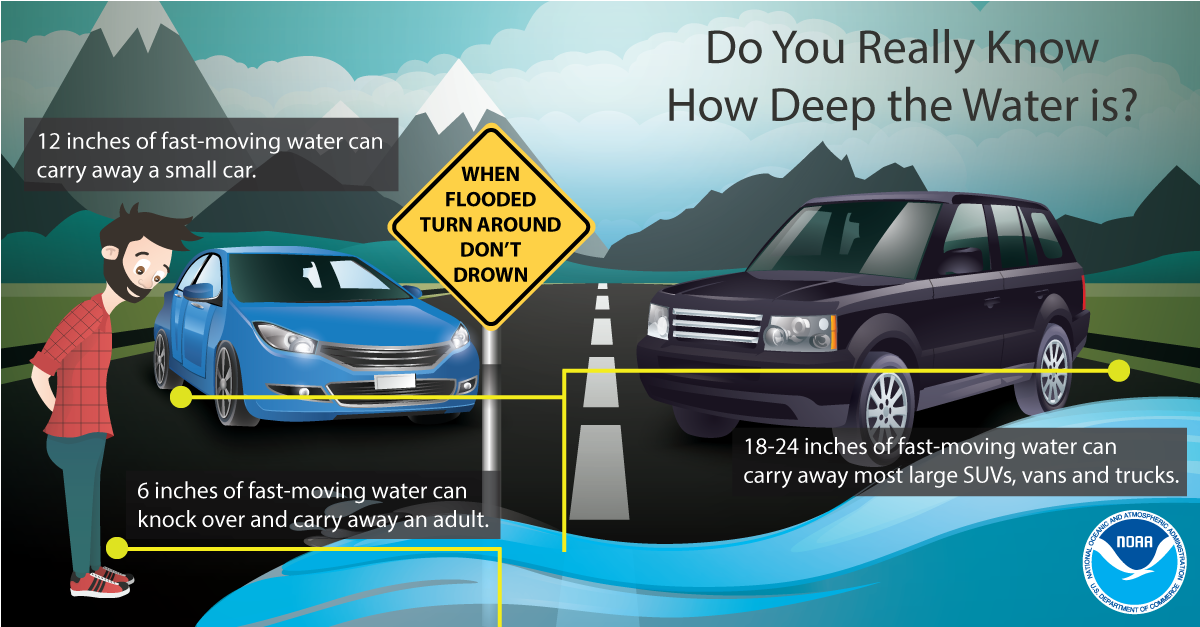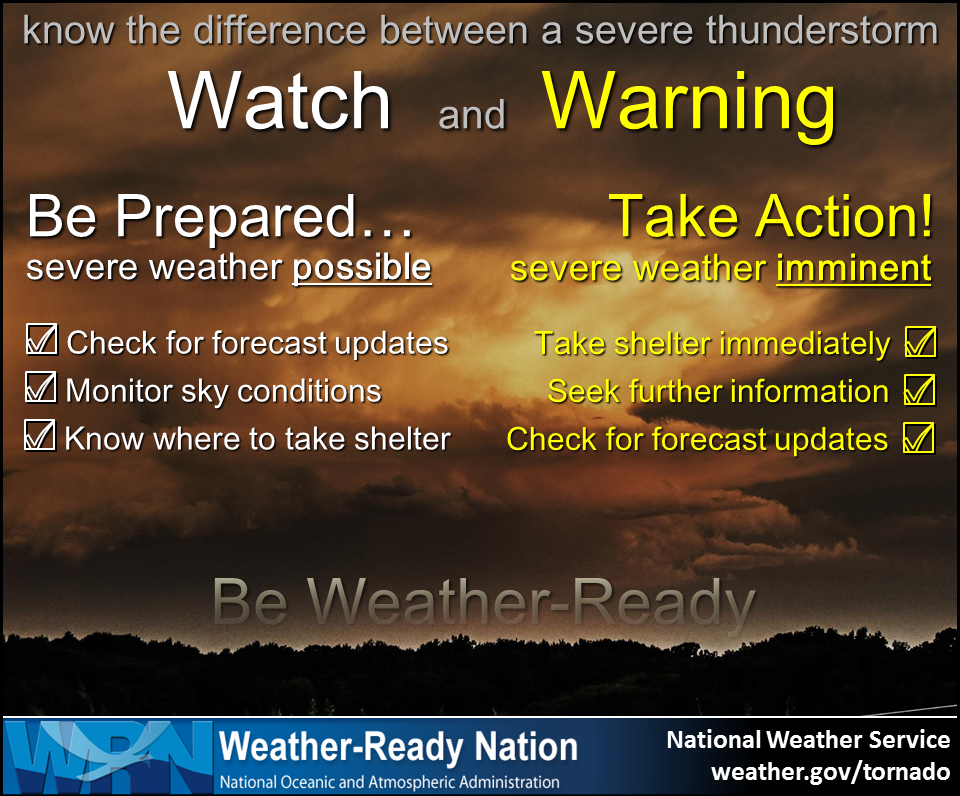Please help the NWS spread these important safety messages on social media! Everyone is welcome to use the text and images provided below to help the NWS build a #WeatherReady Nation. #WeatherReady Wednesday is a National Weather Service initiative to help spread weather safety messages each week. Each week you can pick a different topic to share. It can be based on the current weather or you can share one about weather that you don’t see in your area too often but others might if they are traveling.
Facebook
It’s #WeatherReady Wednesday! Time to get prepared! Don’t let bad weather sneak up on you! Get in the habit of checking weather.gov every morning before you go out. Make sure that you are ready for whatever the day may bring. www.weather.gov
Twitter
#WeatherReady Wednesday! Don’t let bad weather sneak up on you! Check www.weather.gov every day! #SpringSafety

Facebook
The United States Lifesaving Association estimates that over 100 people die each year due to rip currents in the U.S. This #WeatherReady Wednesday, learn how to Break the Grip of the Rip®! www.ripcurrents.noaa.gov/ #SpringSafety #BeachSafety
Twitter
This #WeatherReady Wednesday, learn how to Break the Grip of the Rip®! https://1.usa.gov/QZIviu #BeachSafety #SpringSafety

Facebook
It’s #WeatherReady Wednesday and today we are focusing on beach safety! Only swim at beaches where lifeguards are present. The chance of drowning at a beach with lifeguards is 1 in 18 million. http://www.ripcurrents.noaa.gov #SpringSafety #BeachSafety
Twitter
It’s #WeatherReady Wednesday! Only swim at a beach with lifeguards. http://www.ripcurrents.noaa.gov/ #SpringSafety #BeachSafety

Facebook
It's #WeatherReady Wednesday! Know your risk.
NEVER drive or walk into floodwaters. It is impossible to know how deep the water is just by looking at it. Turn Around Don’t Drown! weather.gov/safety/flood-turn-around-dont-drown #FloodSafety
Twitter
It's #WeatherReady Wednesday! It is impossible to know how deep the water is just by looking at it. weather.gov/safety/flood-turn-around-dont-drown

Facebook
Flooding can occur during any season. This #WeatherReady Wednesday, be prepared. Visit weather.gov/flood to learn more about flooding and how you can prepare before flooding happens. #FloodSafety
Twitter
This #WeatherReady Wednesday, be prepared for flooding. Visit weather.gov/flood #FloodSafety

Facebook
Practice Heat Safety this #WeatherReady Wednesday! Heat is one of the leading causes of weather-related fatalities each year. Heat waves have the potential to cover a large area. Exposing a high number of people to a hazardous combination of heat and humidity can be very taxing on the body. Learn how to stay safe during a heat wave at www.weather.gov/heat #KeepYourCool #HeatSafety
Twitter
This #WeatherReady Wednesday, practice Heat Safety! #KeepYourCool www.weather.gov/heat #HeatSafety

Facebook
It’s #WeatherReady Wednesday! Never leave children, disabled or elderly adults or pets in parked vehicles. Studies have shown that the temperature inside a parked vehicle can rapidly rise to a dangerous level for children, pets and even adults. Leaving the windows slightly open does not significantly decrease the heating rate. The effects can be more severe on children because their bodies have not developed the ability to efficiently regulate their internal temperature. weather.gov/safety/heat-children-pets #HeatSafety #LookBeforeYouLock
Twitter
This #WeatherReady Wednesday, be aware of preventable heat deaths. weather.gov/safety/heat-children-pets #HeatSafety

Facebook
It’s #WeatherReady Wednesday! Thunderstorms can produce deadly lightning capable of striking up to 10 miles away from a storm — so, even if you don't see rain you could be in harm’s way. Remember this simple message: When Thunder Roars, Go Indoors! weather.gov/lightning #LightningSafety
Twitter
It's #WeatherReady Wednesday. When Thunder Roars, Go Indoors! weather.gov/lightning #LightningSafety

Facebook
It’s #WeatherReady Wednesday! Most lightning-related deaths occur when people are having fun outside. If you hear thunder or see lightning, immediately seek shelter in an enclosed building or vehicle. Remember, When Thunder Roars Go Indoors! weather.gov/lightning #LightningSafety
Twitter
It’s #WeatherReady Wednesday! Most lightning-related deaths occur when people are having fun outside. weather.gov/lightning

Facebook
This #WeatherReady Wednesday, watch out for thunderstorms if you're spending time outdoors. Be aware of the forecast before you head out, and know how you will receive a thunderstorm warning if one is issued. Identify where the nearest shelter is located, and if the skies turn threatening, seek shelter immediately. weather.gov/safety/thunderstorm #SpringSafety
Twitter
This #WeatherReady Wednesday, watch out for thunderstorms if you're spending time outdoors. weather.gov/safety/thunderstorm #SpringSafety

Facebook
This #WeatherReady Wednesday, know the difference between a severe thunderstorm Watch and Warning. A severe thunderstorm WATCH means BE PREPARED. A severe thunderstorm WARNING means TAKE ACTION. If there is a severe thunderstorm watch, stay informed and be ready to act, because severe thunderstorms are possible. If there is a severe thunderstorm warning, take shelter in a strong building, and get out of mobile homes that can blow over in high winds. Severe weather is occurring or will shortly. weather.gov/safety/thunderstorm-ww #SpringSafety
Twitter
This #WeatherReady Wednesday, know the difference between a thunderstorm Watch and Warning. weather.gov/safety/thunderstorm-ww

Facebook
This #WeatherReady Wednesday, know the difference between a tornado Watch and Warning. A tornado WATCH means BE PREPARED. A tornado WARNING means TAKE ACTION. weather.gov/safety/tornado-ww #SpringSafety
Twitter
This #WeatherReady Wednesday, know the difference between a tornado Watch and Warning. weather.gov/safety/tornado-ww

Facebook
It’s #WeatherReady Wednesday! Tornadoes can occur at any time of day or night. The nighttime hours are particularly dangerous because most people are sleeping. Wireless Emergency Alerts on your cell phone can let you know if you’re in the path of a tornado. Find out more at https://www.ready.gov/alerts #SpringSafety
Twitter
It’s #WeatherReady Wednesday! Keep Wireless Emergency Alerts on your cell phone can save your life. https://www.ready.gov/alerts #SpringSafety

Facebook
This #WeatherReady Wednesday, prepare for a tsunami. If tsunamis are a threat in your community, you should include tsunami-specific preparations in your emergency plan. Learn the evacuation routes, identify safe places, and practice evacuating. weather.gov/safety/tsunami-before #TsunamiPrep
Twitter
This #WeatherReady Wednesday, if you’re near the coast, prepare for a #tsunami. weather.gov/safety/tsunami-before #TsunamiPrep

Facebook
It’s #WeatherReady Wednesday! Do you live, work or play on the coast? Do you know your community’s tsunami risk? Your community may have identified and mapped tsunami hazard and evacuation zones. Find links to tsunami maps at http://nws.weather.gov/nthmp/maps.html or ask your local/state emergency management office or your local NWS forecast office for more info. #TsunamiPrep
Twitter
It’s #WeatherReady Wednesday! Know your #tsunami risk & evacuation zones. https://nws.weather.gov/nthmp/maps.html #TsunamiPrep

Facebook
It’s #WeatherReady Wednesday! Winter driving can be hazardous. One simple way to keep yourself and everyone on the road safe is to slow down. Remember, “Ice and snow, take it slow”. Learn more at weather.gov/winter #WinterSafety
Twitter
It’s #WeatherReady Wednesday! Do your part to keep everyone safe on the roads this winter. Learn more at weather.gov/winter #WinterSafety

Facebook
It’s #WeatherReady Wednesday! You love your pets, so keep them warm, dry, and well-fed this winter. weather.gov/winter #WinterSafety
Twitter
It’s #WeatherReady Wednesday! You love your pets, so keep them warm, dry, and well-fed this winter. weather.gov/winter #WinterSafety
